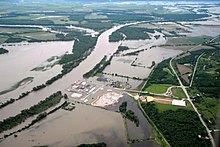Omaha Public Power District
 | |
| Company type | Publicly owned |
|---|---|
| Predecessor | Nebraska Power Company |
| Founded | December 2, 1946 |
| Headquarters | Energy Plaza 444 South 16th Mall, |
Area served | Eastern Nebraska |
Key people |
|
| Services | Electricity |
| Revenue | 1,428,905,000 United States dollar (2023) |
Number of employees | 1,797 (2019) |
| Website | www |
| Footnotes / references [1] | |
Omaha Public Power District (OPPD) is a public electric utility in the state of Nebraska. It is wholly owned by the Nebraska state government, and controlled by a special district. OPPD serves more than 855,000 people in Omaha and 13 surrounding counties in southeast eastern. OPPD was formed in 1946 as a political subdivision of the State of Nebraska, taking over the operations of the privately owned Nebraska Power Company. Nebraska is the only US state in which all electric utilities are government owned. A publicly elected eight-member Board of Directors sets rates and policies.
History
[edit]The Nebraska Unicameral created OPPD as a division of the state government on December 2, 1946. It acquired the Maine-based Nebraska Power Company for $42,000,000 ($656 million in 2023) after a four-year political struggle. Prior to its acquisition, NPC was the only privately owned remaining in the state.[2] In January 1965, the Eastern Nebraska Public Power District was merged into OPPD, adding four counties to its service area. In September 1973, OPPD's Fort Calhoun Nuclear Generating Station entered commercial service. In 1996, OPPD purchased a rail line running from Lincoln to Nebraska City from BNSF Railway. In 2014, OPPD joined the newly created Southwest Power Pool. In December 2019, the board of the Omaha Public Power District voted to commit to net-zero emissions by 2050. A 400- to 600-megawatt solar array is planned, as is the closing of three gas-fired power units, and the conversion of two coal-burning units to natural gas.[3] In 2021, due to a storm, OPPD experienced its largest-ever outage, affecting 188,000 customers.[4][5]
OPPD was named "Highest in Customer Satisfaction among Midsize Utilities in the Midwest" in the J.D. Power and Associates 2009 Electric Utility Residential Customer Satisfaction Study.[6] In 2012, OPPD was awarded its 12th J.D. Power and Associates award.
Facilities
[edit]
OPPD formerly operated the Fort Calhoun Nuclear Generating Station near Fort Calhoun. After 42 years of operation (interrupted by flooding from 2011 to 2013), the plant was shut down on October 25, 2016, and is in the process of being decommissioned.[8] OPPD operates other generating stations in North Omaha, Nebraska City, Valley, Elkhorn and in Cass County; coal, natural gas, oil, wind turbines, solar, and landfill gas are used to generate electricity at their power plants.
OPPD also purchases 81 megawatts of hydroelectricity capacity from the Western Area Power Administration. OPPD has the exclusive rights to power from two privately-operated solar power stations of 5 and 81 megawatts in Fort Calhoun and Saunders County respectively.[9]
See also
[edit]References
[edit]- ^ "Quick Facts" (PDF). OPPD. 21 December 2019. Retrieved 29 October 2020.
- ^ Pennock, Martin H. (1971-05-01). The formation of the Omaha Public Power District (MA thesis). ProQuest LLC. Retrieved 2024-07-20.
- ^ Uhlenhuth, Karen (December 5, 2019). "Nebraska utility bets on technological advances to meet carbon-cutting goals". Energy News Network. Retrieved 2019-12-19.
- ^ "Company History". OPPD. Retrieved 2024-07-20.
- ^ Comstock, Joe (2021-12-08). "A walk through 75 years of OPPD history". The Wire. OPPD. Retrieved 2024-07-20.
- ^ J.D. Power and Associates Archived 2010-01-17 at the Wayback Machine
- ^ OPPD. "Integrated Resource Plan" (PDF). p. 36. Retrieved 2024-07-20.
- ^ Epley, Cole (October 24, 2016). "Today, Fort Calhoun nuclear plant will go offline for good, marking the end of an era at OPPD". Omaha.com. Retrieved 2019-12-19.
- ^ "Service Area Map" (PDF). OPPD. Retrieved 2024-07-20.
External links
[edit]- Official website

- OPPD outage map
- The Wire, OPPD's news publication


 French
French Deutsch
Deutsch